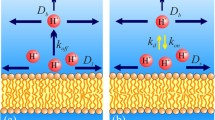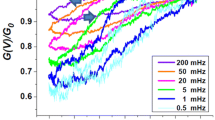Summary
Protonophores have been used frequently to determine changes in membrane potential in suspensions of red cells, since such changes are reflected by changes in extracellular pH, due to proton and consequently protonophore reequilibration.
In a previous paper (Bennekou, P. 1988.J. Membrane Biol. 102:225–234) a kinetic model for the translocation of a protonophore, CCCP, across the human red cell membrane was established. This model accounts for the protonophore reequilibration following abrupt changes in membrane potential.
In this paper, the limitations of the method with regard to the estimation of transient membrane potentials are examined, using the transport model to simulate changes in extracellular pH in response to noninstantaneous changes in membrane potential. The temperature and time resolution calculated from the model are reported.
Furthermore, it is shown that the transport model established for CCCP is valid for another protonophore, TCS, thus indicating the general validity of the transport scheme for the entire class of protonophores.
Similar content being viewed by others
References
Bennekou, P. 1984. K+-valinomycin and chloride conductance of the human red cell membrane: Influence of the membrane protonophore carbonylcyanidem-chlorophenylhydrazone.Biochim. Biophys. Acta 776:1–9
Bennekou, P. 1988. Protonophore anion permeability of the human red cell membrane determined in the presence of valinomycin.J. Membrane Biol. 102:225–234
Bennekou, P., Christophersen, P. 1986. Flux ratio of valinomycin-mediated K+ fluxes across the human red cell membrane in the presence of the protonophore CCCP.J. Membrane Biol. 93:221–227
Macey, R.I., Adorante, J.S., Orme, F.W. 1978. Erythrocyte membrane potentials determined by hydrogen ion distribution.Biochim. Biophys. Acta 512:284–295
Macey, R.I., Orme, F.W. 1980. Permeability of red cells to lipid soluble ions.In: Membrane Transport in Erythrocytes. Alfred Benzon Symposium 14. U.V. Lassen H.H. Ussing and J.O. Wieth, editors, pp. 498–512. Munksgaard, Copenhagen
McLaughlin, S.G.A., Dilger, J.P. 1980. Transport of protons across membranes by weak acids.Physiol. Rev. 60:825–864
Press, W.H., Flannery, B.P., Teukolsky, S.A., Vetterling, W.T. 1986. Numerical Recipes. Cambridge University Press, Cambridge
Neumcke, B., Bamberg, E. 1975. The action of uncouplers on lipid bilayer membranes.In: Membranes: A Series of Advances Vol. 3. pp. 215–254. G. Eisenman, editor. Marcel Dekker, New York
Sadykov, Y.H., Holmuhamedov, E.L., Evtodienko, V. 1984. Effect of pH and proton buffer on oscillations of ion fluxes in rat erythrocytes.Eur. J. Biochem. 143:369–371
Vestergaard-Bogind, B. 1983. Spontaneous inactivation of the Ca2+-sensitive K+ channels of human red cells at high intracellular Ca2+ activity.Biochim. Biophys. Acta 730:285–294
Vestergaard-Bogind, B., Bennekou, P. 1982. Calcium-induced oscillations in K+ conductance and membrane potential of human erythrocytes mediated by the ionophore A23187.Biochim. Biophys. Acta 688:37–44
Author information
Authors and Affiliations
Rights and permissions
About this article
Cite this article
Bennekou, P. Steady-state and transient membrane potentials in human red cells determined by protonophore-mediated pH changes. J. Membrain Biol. 106, 41–46 (1988). https://doi.org/10.1007/BF01871765
Received:
Revised:
Issue Date:
DOI: https://doi.org/10.1007/BF01871765




